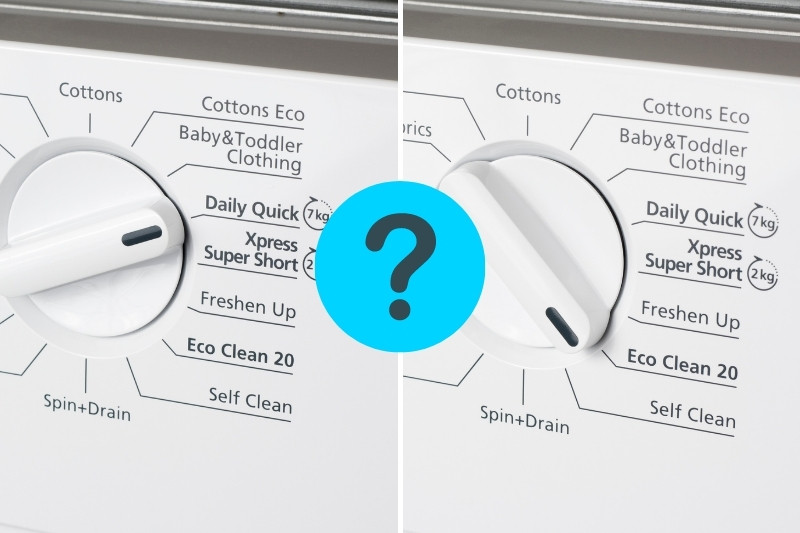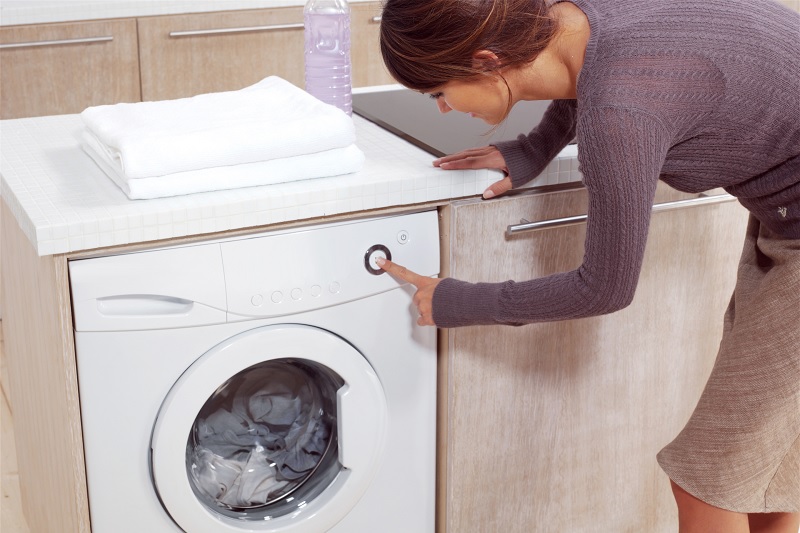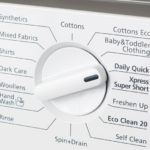Washing machines come with loads of buttons to press, a dial with an abundance of programs listed around it, and fancy apps that help you run the machine.
Yet, when it boils down to the basics, choosing the right program to clean your laundry can be more difficult than it looks. And no amount of fancy tech can help you out!
Do you need a quick wash for a t-shirt? A cotton program for some bedding? Or a hand wash cycle for some undies? So, many questions!
So, let’s not waste any more time, join me and find out what these cycles mean and when you should be using them!
Quick Wash Cycle vs Normal Washing Cycle
With so many cycles to choose from, picking the right program can be quite a daunting task. Especially when you know that one wrong move could leave you with a shrunken jumper!
So, without further ado, let’s discover what these cycles actually mean and when’s the right time to use them!
What is a quick wash cycle?
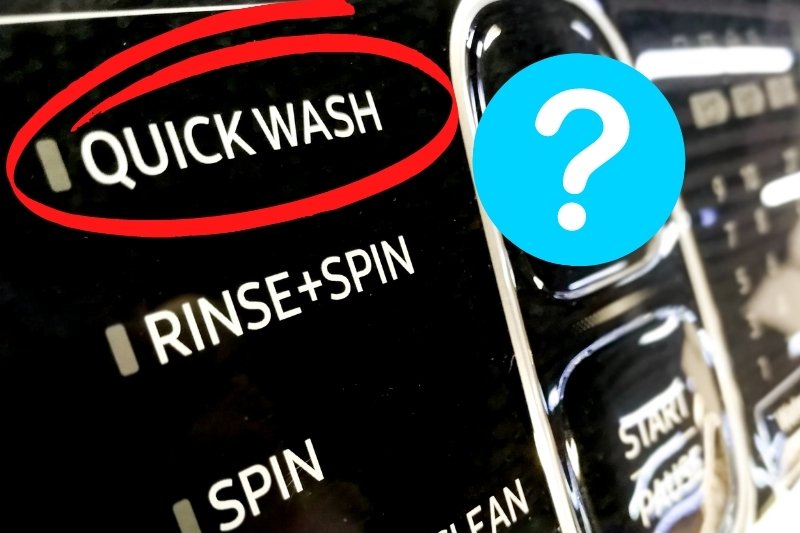
A quick wash cycle, as the name suggests, is one of the shortest and fastest cycles you can run to clean your laundry.
Typically, quick wash cycles are between 14 minutes to one hour in length, and this makes them perfect to run when you forget to wash a uniform, or you need a top cleaned ready for a night out that evening.
Such a cycle is usually run with far less laundry than a normal wash. In a lot of cases, you can only put a fraction of dirty clothes in to wash at once. This can be as little as one to two kg of clothes, whereas a full drum may be about seven kg.
There are, of course, some washing machines that allow you to wash a full drum of laundry on a quick wash cycle, but the laundry in question usually isn’t that dirty to begin with, and the items don’t require an intense wash. But this is quite rare though!
On that note, a quick wash cycle is generally very good at washing lightly soiled clothes, but you should be wary of washing heavily soiled items on a cycle like this (unless instructed to do so). Clothes may not come out as clean as you’d like after a quick wash cycle, so it would be better to either pre-treat these items, or to use a normal washing cycle to clean them.
Further to this, you’ll notice that unless you actually change the temperature of the water yourself, most quick washes use water that is about 30℃ or colder.
The lack of very hot water is one of the reasons why you should only be cleaning lightly soiled clothes, because the water usually isn’t hot enough to remove tough dirt.
Benefits of using a quick wash cycle:
- Great when you’re in a rush.
- Can wash small amounts of laundry quickly.
- Can smarten up slightly dirty clothes.
- Saves you time.
Drawbacks of using a quick wash cycle:
- You can’t wash lots of laundry at once.
- You cannot clean severely dirty clothes.
- Spin feature might not be as effective as you’d like it to be, so clothes may feel wetter.
- Rinse feature may not be as powerful as you’d hope it would be, so soapy residue may be left on laundry.
When should you use a quick wash cycle?
A quick wash cycle should be used during the following times:
- When you have items that need a quick spruce up.
- For garments that are lightly soiled.
- When you desperately need something washed.
- When you need to wash items that are stain-free.
When should you avoid using a quick wash cycle?
Unfortunately, a quick wash cycle isn’t going to be suitable all the time. So, here’s when you should avoid using this kind of program:
- When you have heavily stained clothes that need to be treated.
- When laundry is absolutely filthy and needs to be deep cleaned.
- Heavy duty clothes that are plagued by oils and dirt shouldn’t be washed on this setting.
- Delicate materials can snag or ruin when washed on this cycle.
- When a deep clean is required – the duration and water temperature won’t be suitable.
- When you need to wash laundry in very hot water to remove bacteria – towels and bedding, for example.
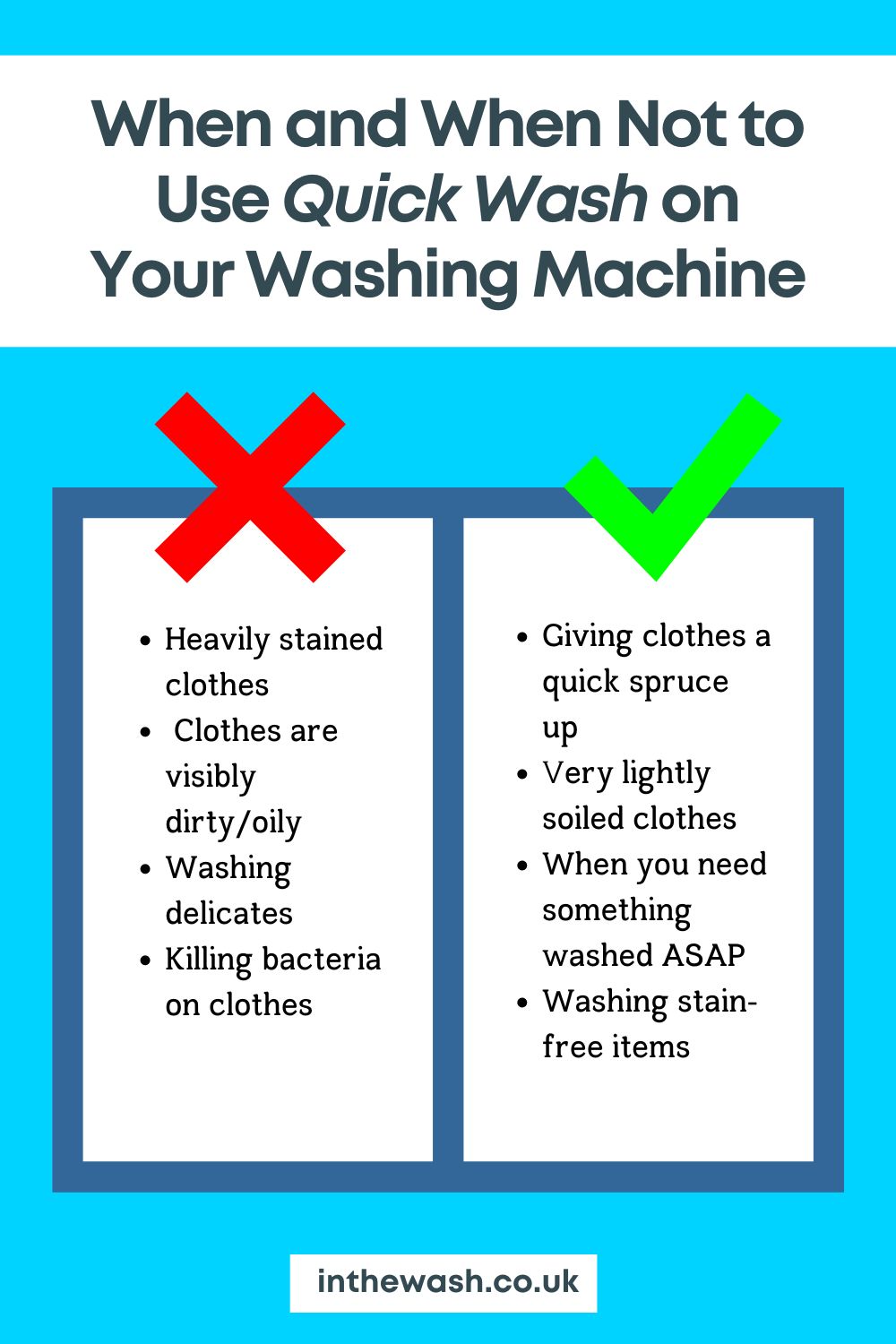
What is a normal washing cycle?
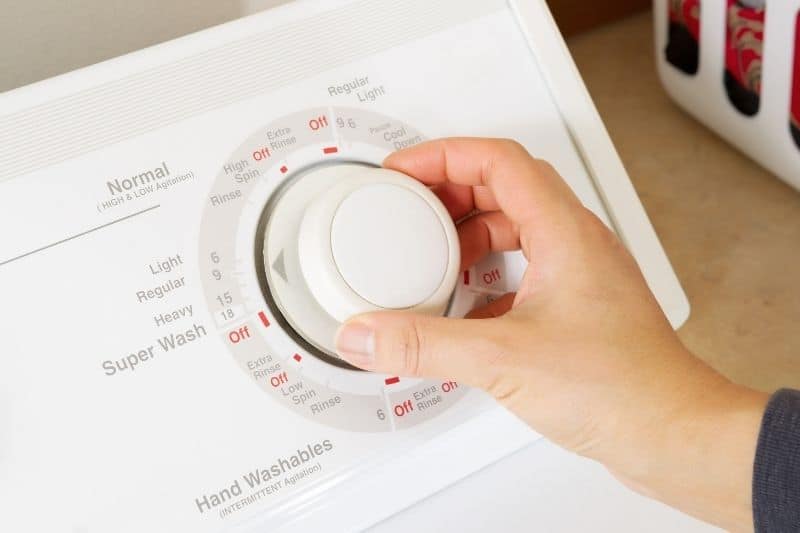
A ‘normal’ wash cycle, for the purposes of this article, refers to any other program that you see labelled on your washing machine.
There is a plethora of different cycles to be had, and below you will find the most common programs that are found on most washing machines, both old and modern.
Note: Some of you may classify a ‘normal’ cycle as a cotton cycle, but a ‘normal cycle’ in this article will be treated as anything that isn’t a quick wash cycle.
Examples of ‘normal washing cycles’ include the following:
- Cotton cycle
- Synthetics cycle
- Wool cycle
- Hand wash cycle
- Delicate cycle
- Temperature washers
Depending on the washing machine you’ve got at home, you might see more or less cycles listed on the front.
Let’s take a look at each of these cycles in a little more detail.
Cotton
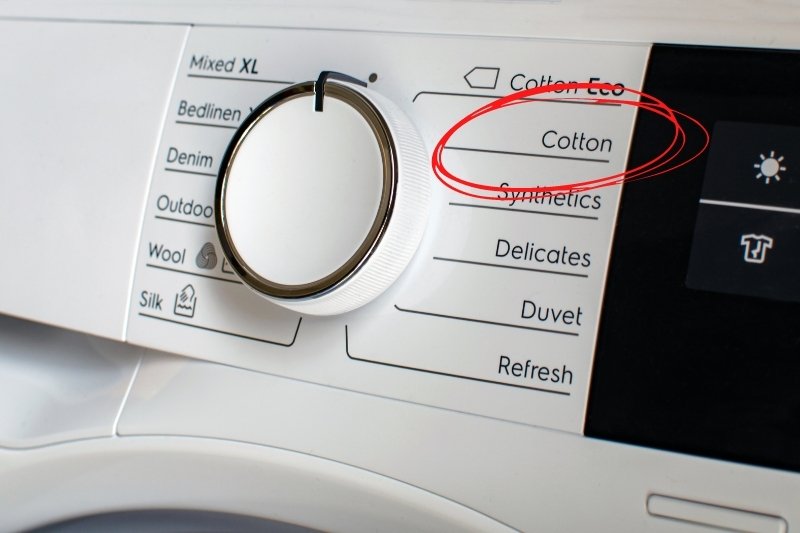
The cotton cycle is one of the hottest programs you can run, and it is generally used to clean tougher materials, like cotton.
The high heat, usually about 60℃, allows bacteria to be killed off quickly, and deep cleans can be performed on soiled items.
In general, bedding, towels, underwear and cotton clothes are washed on this setting.
Synthetics

A synthetics cycle, as you might’ve guessed, is designed for synthetic items to be laundered on.
Generally, polyester clothes are washed on this program because the cycle uses a lower water temperature of around 40℃, and there’s less of a spinning motion.
This prevents the material from being ruined, but the lack of intense agitation may prevent toughened dirt from being removed from garments.
Wool, hand wash, delicate
Wool, hand wash and delicate cycles, in contrast, run on much lower water temperatures, and it’s this low heat that protects the delicate material from getting damaged.
You’ll also notice that the drum will not spin as fast during such cycles. The less agitation the laundry has to go through, the less likely it is to get pulled and snagged.
Items washed on this cycle include delicate clothes that can rip easily, silks and lingerie.
Temperature cycles

Temperature cycles, in turn, are programs where the user picks a temperature to wash their laundry on.
These temperatures usually go from cold to 90℃, but it’s very rare that you will have to wash clothes at such a high temperature.
The hotter the temperature, the better it’ll be at removing tough stains, and the colder the water, the better it’ll be at cleaning lightly soiled garments.
Differences between quick wash and normal cycles
As you can see there are different normal cycles you can run, and each one is specifically designed to wash a particular type of laundry.
This is different to a quick wash because there’s more choice available, you can pick a program that is suitable for your laundry, and you can actually wash heavily soiled clothes on the majority of these cycles.
Another major difference between a quick wash and a normal wash is the length of time each of these cycles take, generally normal cycles take longer to complete.
Each cycle varies from one brand to another, but on average a cotton cycle will take about an hour and a half to complete, a synthetic cycle can take up to two and a half hours to run, and delicate/hand wash cycles can take about three-quarters of an hour to finish.
Benefits of using a normal wash cycle:
- Specialised cycles to clean specific materials.
- Different water temperatures to suit different laundry jobs.
- More choice for the user.
- Can take care of your laundry in the way that’s right for it.
- Cycles can actually clean stains away.
- Programs can clean heavily soiled clothes.
Drawbacks of using a normal wash cycle:
- Can be slow.
- Some cycles are expensive to run because they take such a long time to run through.
- Having more choice means that you might pick the wrong cycle for the laundry you plan on washing.
When should you use a normal wash cycle?
You should only use a normal wash cycle after you have gone through, and sorted out, your laundry into separate washing piles.
Once you’ve got your individual washing piles, you can pop them in the washer, and choose the correct cycle to clean the laundry on.
Additionally, you can use a normal washing cycle to clean larger piles of laundry, soiled laundry, stained laundry, and to wash specific materials that could not be washed on a quick wash (silk would get ruined on such a program, for example).
What does laundry sorting look like in action? Follow this guide:
- You go to your washing basket and start separating your clothes into coloured and white piles.
- Once you’ve got two piles of laundry, you can go over to one pile, let’s say colours, and start sorting them out again.
- This time you can sort the colour pile of laundry out by material – cottons, synthetics and silk, for example – check the tag on the items.
- You’ll likely end up with more piles of laundry – coloured cottons, coloured synthetics and coloured delicates, for example.
- Next, you need to go through these smaller piles and find out how they should be washed by reading their tags again.
- Some clothes may be hand wash only, so they should be put into a separate pile.
- Once you’ve sorted the piles out even more, you can take them down one at a time to the washing machine.
- All you need to do then is check the laundry for a stray item of clothing as you’re popping the dirty washing into the machine. Then you need to choose the correct setting, let’s say ‘Cotton cycle’, add detergent for coloured clothes and start the cycle.
Yes, this process may sound very time consuming, but it’s a worthwhile exercise to carry out. Not only does it mean that your laundry will be washed in a way that’s appropriate for it, but you’re also ensuring that the materials in question don’t get ruined.
Plus, you can buy laundry baskets that can help you to organise your laundry, so you can speed up this entire process! And you’ll get used to sorting the dirty washing out the more you do it.
When should you avoid using a normal wash cycle?
Normal washing cycles can usually cover most of your laundry needs, so there aren’t many examples of times when they shouldn’t really be used.
However, there are times when they may not be as convenient to use, in comparison to a quick wash.
For example, if you’ve only got a few slightly dirty tops to wash, it might be more economical both time wise and financially, to run a quick wash instead.
A normal wash in this case may be overly long, and you might end up running a mostly empty washing machine too.
Running such empty cycles may cause more harm than it’s worth to your machine in the long run because it can become unbalanced – this might be an expensive repair job.
But in general, if you’ve got the time, plenty of laundry to wash, and items that are extra dirty, you should use a normal wash.
What’s Better: A Quick Wash or Normal Wash Cycle?
A quick wash cycle is very convenient to use, and it can clean slightly dirty clothes very well.
However, some materials may get ruined if they’re put into a quick wash environment, and the program rarely cleans extremely dirty clothes well. So, it isn’t always suitable.
On the flip side, normal washing cycles can be used to clean specific materials, you get to use water temperatures that are suitable for the laundry you are washing, you get to clean lots of laundry at once, your laundry gets exposed to the correct amount of agitation if you pick a suitable setting, and you can launder the dirties of clothes on these cycles.
The main drawback is that most of the time these normal cycles take a lot longer to run through, which makes them less convenient to use.
But when you look at a quick wash cycle and a normal wash cycle for what they really are, you’ll notice that there’s merit to using both of them. And if you use the cycles at the right time, and under the right circumstances, you should get clean clothes without any trouble!
Does A Quick Wash Actually Work?
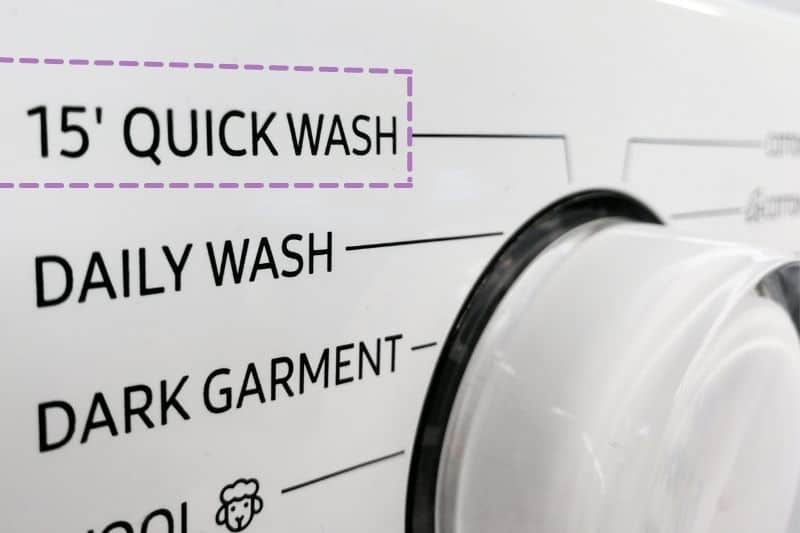
Yes, a quick wash cycle does work. But you must adhere to the rules of the quick wash cycle to get the most out of it.
So, you should only wash a few garments at a time (unless you’re told otherwise), the items in question should be free from stains, and should only need to be spruced up a little.
However, if you misuse the quick wash cycle, for example, you overload the cycle, the clothes are very dirty and your laundry is heavily stained, then you probably won’t end up with clean clothes in the end. In this case, running a quick wash cycle will have been completely pointless for you.
And, what’s more, you’re going to have to waste more time, energy and money rewashing the clothes that you could’ve washed on an appropriate setting to start off with.
In addition to this, you should remember to adjust the water temperature when you run a quick wash, so that you can actually get rid of the bacteria on your clothes. If you don’t change the temperature to a hotter setting, you risk leaving germs on your laundry, which is a bit yucky!
How Long Do Normal Cycles Take?
It’s difficult to pin-point exactly how long each normal cycle will take because these times vary from brand to brand, and from one model to another.
Here’s a brief guide to follow:
- Cotton cycles can be between one hour and thirty minutes to more than four hours.
- Synthetic cycles can be between two and a half hours to three hours.
- Hand wash and delicate cycles can be between three-quarters of an hour to an hour and a half.
- Temperature cycles usually vary.
For more info, see our in-depth guide on how long common washing cycles take across top washing machine brands.

Bethan has a passion for exploring, reading, cooking and gardening! When she’s not creating culinary delights for her family, she’s concocting potions to keep her house clean!
